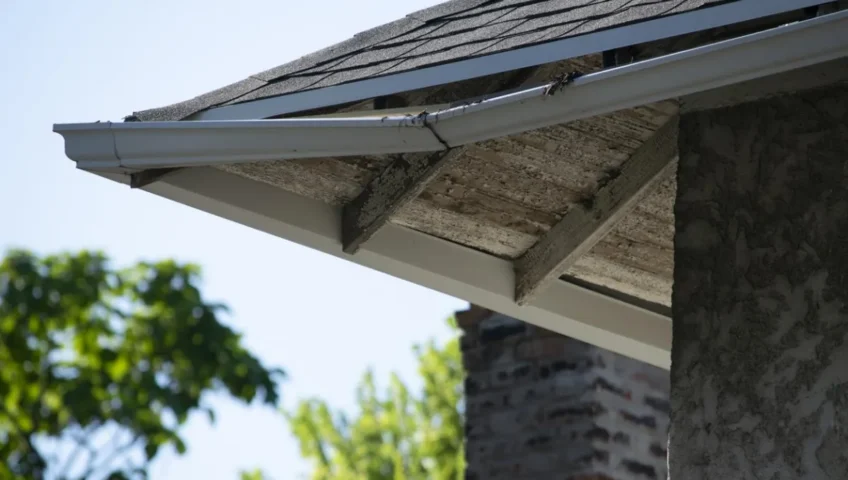Loose gutters can cause severe water damage by allowing leaks and overflow near your home’s foundation or roofline. Common signs to look for include sagging, pulling away from the house, gaps, and damaged fascia boards. You can often fix the issue by tightening fasteners or adding brackets, but the fascia may need to be replaced if there’s wood rot behind the gutters. When the damage is extensive or DIY fixes don’t last, it’s best to call a pro. Knowing the signs and how to respond helps you act early and avoid costly repairs.
Key Takeaways
- Loose gutters often show visible signs like sagging or pulling away.
- Simple repairs like tightening or adding supports can fix many gutter issues.
- Severe damage may require professional help to ensure a proper fix.
Recognizing The Warning Signs: How to Tell If Your Gutters Are Loose
We need to know exactly what to look for and listen to to spot loose gutters early. This helps us fix problems before they get worse. Pay attention to how gutters look, sound and how water behaves around them.
Visual Cues
One of the clearest signs of loose gutters is sagging or bowing along the gutter line. When gutters hang lower than usual or pull away from the house, their supports are failing or missing.
Look for gutters that lean out or have stretched too far between brackets. Cracks or gaps where gutters connect can also indicate looseness.
Check gutter fasteners. If you see rusted or missing spikes and screws the gutters are less secure and may move with wind or water. Sometimes debris builds up in the gutters, making the sag worse.
Audible Clues
We can often hear loose gutters before we see them. Excessive dripping, loud water flow, or clanking noises during rain suggest a problem.
If gutters rattle in the wind or shake when tapped lightly, they might be loose. Loose gutters move and make noise that tight, secure gutters do not.
Unusual sounds mean our gutters are not firmly anchored and could soon fall or fail. Listen carefully during storms or windy days to get clues about their condition.
Evidence Of Water Damage
Water leaking behind gutters or pooling in unusual places is a strong warning sign. When gutters are loose, water can escape through openings and soak the home’s exterior.
Look for water stains or rot on siding or fascia boards near the gutters. Puddles or erosion below gutters means poor drainage caused by looseness. Water in gutters or overflow during rain means the gutters can’t handle water properly. This puts extra stress on the supports and can loosen them further. Detecting water damage early protects the house structure.
DIY Fixes For Loose Gutters (But Put Safety First)
We must focus on simple, practical steps to safely secure loose gutters. Using the right tools and precautions will help us strengthen gutters without causing damage or injury.
Tightening Loose Fasteners
Loose fasteners like screws or spikes are common causes of gutter problems. First, scrutinize all fasteners.
If screws are loose, use a screwdriver or drill to tighten them firmly. Don’t overtighten, or you could strip the hole. Gently hammer nails or spikes back in place.
If fastener holes are worn out, fill them with exterior-grade wood filler or use a larger screw to ensure a secure fit. Replacing old spikes with screws or gutter-specific fasteners can improve their long-term hold.
Safety tip: Use a sturdy ladder on level ground and wear gloves to protect your hands.
Re-Securing Loose Brackets/Hangers
Brackets or hangers hold gutters to the fascia board. If they are loose or damaged, gutters may sag or pull away.
If damaged, remove the old bracket. Then, using galvanized steel hangers, attach new brackets every 2-3 feet along the gutter. Secure the brackets firmly to the fascia with corrosion-resistant screws.
Check that the gutter slope remains correct, tilting slightly toward the downspout so water can flow freely.
If the gutter slope is correct, check for wood fascia rot. If rotten, we may need to repair or replace that part before attaching hangers again.
Re-Hanging Minorly Sagging Sections
Sagging often occurs when gutters fill with debris or hangers loosen over time. We can fix minor sagging by carefully lifting the gutter.
Support the loose section on a ladder, then re-align it and re-secure with existing or new hangers. Adding hidden hangers inside the gutter can provide extra support without changing its appearance.
If sagging is due to standing water, ensure the gutter is clear and slopes properly. We can test this by running water through the system.
Cleaning Gutters to Reduce Strain
Cleaning gutters regularly reduces the weight and strain that can cause loosening or sagging.
Remove leaves, twigs, and dirt by hand or with a scoop. Flush gutters and downspouts with a garden hose to clear out blockages.
Check for trapped debris near downspouts or gutter valleys, as these areas are more prone to blockages. We recommend calling a professional when you see big sagging or large sections of gutters pulling away from your home. This kind of damage usually means the gutter system is compromised and needs professional help.
If the fascia board behind the gutters is rotten or damaged, it’s best to get help. Repairing or replacing the fascia requires care and expertise to avoid further problems.
When gutters keep coming loose after repairs, there’s probably a bigger issue at play. Professionals can inspect and fix the root cause so the problem doesn’t come back.
Many homeowners don’t have the tools or feel safe working on ladders and roofs. But we have the right equipment and training to handle gutter installation safely and efficiently.
Choosing us means you get a durable, professional solution. We use quality gutter materials and proper techniques to make sure gutters stay secure for years.
| Signs You Need Professionals | Reasons to Call Us |
| Large gutter sections sagging or detached | Safe, trained work at heights |
| Rotted or damaged fascia board behind gutters | Access to specialized tools |
| Persistent loosening despite fixes | Long-lasting, professional results |
When you want gutters fixed the right way, it’s smart to let us handle it.
A Little Gutter Maintenance Goes a Long Way
Staying ahead of loose gutter issues is one of the most innovative ways to protect your home from water damage. Sagging, leaning, or separating gutters are early warning signs often caused by clogs or moisture-related wear. The good news? A little regular maintenance goes a long way. Make it a habit to inspect, clean, and secure your gutters regularly, and don’t wait to repair or replace any damaged sections. Call a professional to save time and headaches later if the problem seems beyond a quick fix. These simple steps keep water where it should be and your home’s foundation and exterior safe.
Ready to keep your gutters in top shape? Contact New Vision Exterior Solutions today to schedule your free gutter inspection and repair—call us to get started!

